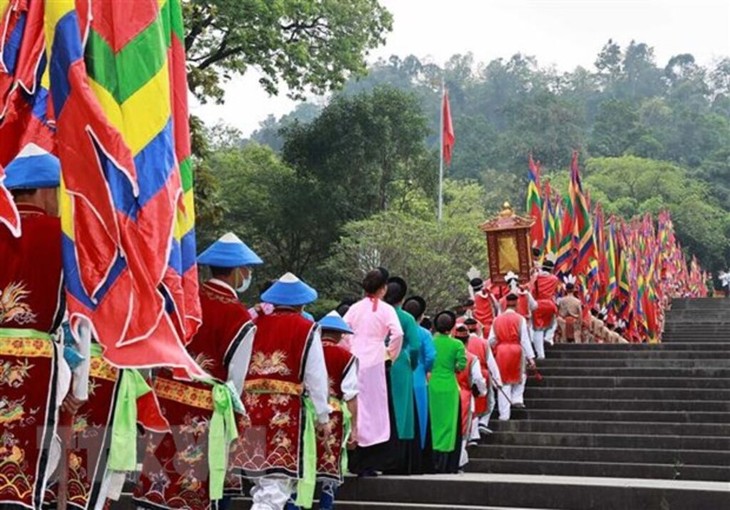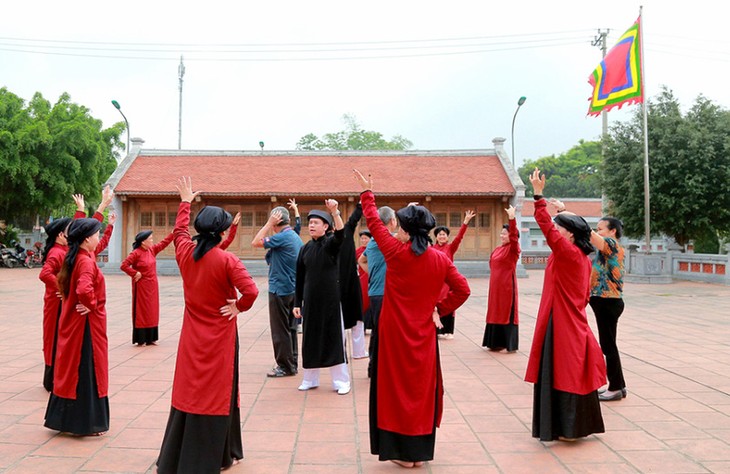(VOVWORLD) - On the pilgrimage to the ancestral land of the Hung Kings in Phu Tho province, visitors often stop by Hung Lo, a 300-year-old village stretching along the banks of the Lo River. This village is home to a rich collection of historical and cultural relics, deeply intertwined with the legends of the Hung Kings, the founders of the Vietnamese nation, including sacred worship rituals and the folk art of Xoan singing.
 The procession to the Hung Kings Temple (photo: VNA) The procession to the Hung Kings Temple (photo: VNA) |
During the Hung Kings’ regime from the 7th century BC to the 2nd century BC, Hung Lo village was named Trang Kha Lam, built on prosperous land on the outskirts of the capital of Van Lang. The village was renamed several times before finally being named Hung Lo Commune after the 1945 August Revolution. It retains the distinctive characteristics of an ancient Vietnamese village, with Hung Lo Communal House as the most prominent landmark.
According to legends, Trang Kha Lam was once a resting place for the Hung Kings, his family members, and courtiers during a journey. Impressed by the land's prosperity, lush vegetation, and sacred energy, the King decided to build a village here. Later, the villagers built a shrine to worship the Hung Kings and express their eternal gratitude. In 1697, during the reign of King Le Hy Tong, a communal house was constructed, facing Nghia Linh Mountain.
Nguyen Van Tong, the caretaker of Hung Lo Communal House, said: "The complex includes a temple, a communal house, a research hall, a house for village elders, a ceremonial house, and an altar for the God of Agriculture, where villagers pray for favorable weather, bountiful harvests, and prosperity. Hung Lo Communal House received 11 recognition decrees from various dynasties, including those of Kings Quang Trung, Gia Long, Thieu Tri, and Tu Duc. These decrees have been preserved intact to pass down to future generations."
Through hundreds of years, Hung Lo Communal House has amazingly maintained its original architecture and was recognized as a national historical site in 1990. Visitors can witness its timeless charm in the moss-covered gates, intricate decorative motifs, and tiled roofs. The village also preserves an extensive collection of ceremonial artifacts, including 43 parallel sentences in praise of the homeland and the Hung Kings’ merits.
La Thi Hong Thuy, a cultural officer of Hung Lo commune, said: “Hung Lo Communal House is regarded as a miniature museum, preserving numerous precious objects. Among them are five exquisitely gilded palanquins, traditionally used to carry ceremonial offerings to the Hung Kings’ Temple during the annual Hung Kings' death anniversary on the 10th day of the third lunar month and the Hung Lo Village Festival. In 1918, the commune was honored by the Nguyen Dynasty with an inscribed plaque reading ‘Hung Lo – The Top Festival.’
 Xoan dance and singing, a legacy ò the Hung Kings's worship (photo: baophapluat.vn) Xoan dance and singing, a legacy ò the Hung Kings's worship (photo: baophapluat.vn) |
For generations, Hung Lo Communal House has played a vital role in the spiritual and cultural life of the locals. The Xom Village Festival used to be held twice a year: during the commemoration of the Hung Kings on March 10 and the local deity on September 12 of the lunar calendar. The preservation of ancient ceremonial objects and rituals reflects the villagers' deep respect for history and their dedication to safeguarding cultural heritage, particularly the legacy of the Hung Kings' worship.
Amidst the resounding festival drums, locals and visitors eagerly participate in the festivities, with hearts full of devotion as they pay tribute to the Hung Kings.
Beyond its role as a worship site, Hung Lo Communal House is also a venue for cultural festivities, including Xoan singing, a traditional folk art recognized by UNESCO as an Intangible Cultural Heritage of Humanity.
Hung Lo is one of four original Xoan guilds in Phu Tho Province that continue to preserve and perform this ancient art form.
Phung Thi Hoa Le, Head of the Tourism Office of the Phu Tho Department of Culture, Sports, and Tourism, said: "When visiting Hung Lo ancient village, tourists can enjoy a complete Xoan performance, consisting of three segments: sacred worship singing, alternative singing, and festive singing. This unique art form offers a glimpse into the rich cultural heritage dating back to the era of the Hung Kings. The plain singing style, accompanied only by drums and wooden clappers, and graceful hand and foot movements create the distinctive elegance of Xoan singing."
In addition to the 300-year-old communal house, Hung Lo village has around 50 traditional houses built centuries ago. These wooden, bamboo, and thatched-roof houses feature exquisite carvings of dragons, unicorns, turtles, phoenixes, and floral motifs, showcasing the architectural heritage of Vietnam’s wet-rice civilization.
La Tien Boong, Vice Chairman of the Hung Lo Commune People's Committee, said: "The local administration has encouraged the locals to preserve and promote traditional heritage. While supporting the development of handicrafts to boost the local economy, we have well preserved the ancient houses."
Hung Lo embodies the rich cultural legacy of the Hung Kings’ era and the tranquility of a Vietnamese village. This heritage continues to be safeguarded by the local community, ensuring its endurance through the ages.